by Virginia Wood
JOURNAL OF CHINESE MEDICINE , OCTOBER 1999
When a woman fails to become pregnant after one year of trying and where the reproductive function of her partner is normal, the condition is referred to as infertility. In Chinese medicine the main patterns for infertility are considered to be:
1. Congenital deficiency of Kidney qi and deficiency of Kidney yang which results in failure of yang to warm the uterus.
2. Deficiency of Kidney essence (jing) and blood with the result that the Penetrating (Chong) and Conception (Ren) vessels, and the channels and collaterals of the uterus, fail to be nourished. If there is Kidney yin deficiency, this may lead to hyperactivity of fire which will stir up and aggravate the Liver and the Heart and consequently heat will accumulate in the blood.
3. Stagnation of Liver qi which creates disharmony of qi and blood and injures the Spleen. Disharmony of the Liver and Spleen will result in the impaired production and flow of qi and blood which therefore fail to fill up and support the Penetrating and Conception vessels.
4. Spleen qi deficiency gives rise to both blood deficiency and the breakdown of transformation and transportation creating phlegm and dampness in the interior. This affects qi circulation and can cause blockage in the collaterals of the uterus, fallopian tubes and ovaries.
5. Blood stagnation arising from incomplete expulsion of blood from the uterus or residual blood in the pelvic cavity (as in endometriosis). Blood will then coagulate and block the collaterals of the uterus and reproductive organs.
6. Disharmony between the Heart and Kidney whereby the Kidney fails to nourish the Heart and the Heart fails to warm the Kidneys. In cases of disturbance of the spirit (shen) the Heart qi will not descend and the relationship between the Heart, Kidney and the uterus breaks down.
7. Impaired function of the Sanjiao. The Sanjiao controls the pathway of fluids in the body and is therefore essential in maintaining the flow of qi and blood to and from the Heart, the Kidneys and the uterus.
8. An impaired uterus, either due to maldevelopment, flaccidity, prolapse, damaged endometrium, phlegm, heat or cold in the uterus, and most importantly impairment of the functions of ‘conserving’ and ‘eliminating’ will affect fertility. Zigong (the uterus) means “a palace for the nurturing of the foetus”. It is therefore essential to ensure a healthy uterus.
The Kidneys however hold the most essential key to fertility. The ‘tian gui’ is the essence of the Kidneys and governs maturity and the ability to reproduce, whilst it is said that “menstrual blood issues from the Kidneys”. The baomai (the uterine vessel) directly links the Heart to the Kidneys. The Heart and Kidneys both belong to shaoyin and exemplify nothing less than the essential difference between, and yet utter inter-dependence of, yin and yang, the Kidney essence and the Heart spirit, the Kidney water and Heart fire. Finally the confluence and flow of the Conception and Governing vessels influence the uterus and maintain the regularity of the monthly menstrual cycle.
Hormonal changes through the menstrual cycle
During the first half of the cycle (the oestrogen enriching phase) the yin begins to grow, starting immediately after the menstrual bleed. It reaches its peak at ovulation and the transformation from the yin to the yang phase begins. The progesterone levels then rise and peak around days 20-22, and then falls towards the end of the cycle. The hormone levels then drop and the menstrual cycle begins again.
Changes in BBT through the menstrual cycle
The BBT is most accurate if taken at the same time each day before rising, using the same thermometer and method each time. The readings are then marked on a fertility chart starting from the first day of the menstrual cycle.
On day 1 of the menstrual cycle (the first day of bleeding), the normal BBT is around 36.5°C and should remain so until just before ovulation when it will suddenly drop and ovulation will occur. After ovulation the temperature will quickly rise and reach its peak within 2-3 days. The difference between the pre-ovulatory reading and that of the second phase should be at least 0.4°C. If, for example, the low phase is too high or the high phase is too low, the difference is too small, indicating an incomplete yin phase or incomplete yang phase respectively.
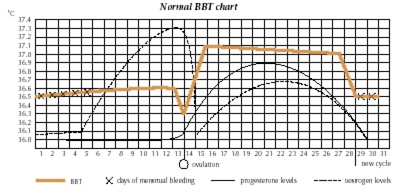
How to use the Basal Body Temperature in Diagnosis
By monitoring the changes in a woman’s basal body temperature (BBT) we can see how her menstrual cycle is progressing.
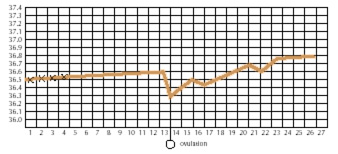
If the temperature in the post ovulatory phase rises too slowly or insufficiently it indicates low progesterone and Kidney yang deficiency, or may also be due to insufficient yin which is unable to provide the material basis for yang to rise.
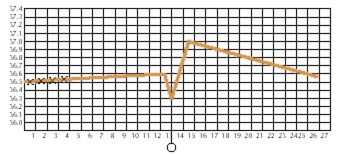
If the temperature rises but is not maintained for at least I2 days and gradually falls, it shows the luteal phase is insufficient and the yang qi is declining. In such cases there may also be qi deficiency. There my also be mid-cycle spotting and possibly endometriosis. If the high phase is less than 10 to 12 days, the severity of Kidney yang deficiency is indicated by how short this phase of raised temperature is.
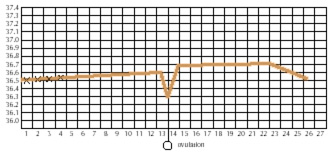
If the temperature rises, but less than .4°C, there is Kidney yang deficiency with possible qi or yin deficiency, depending on the symptoms.
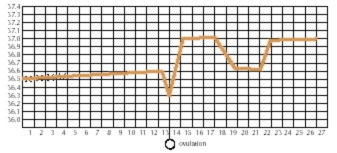
If the chart drops then rises again it indicates that the corpus luteum is not functioning properly and there is possible insufficiency of Spleen and Stomach qi to support the Kidney.
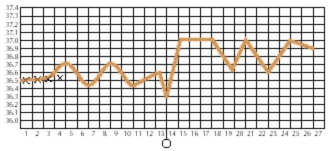
A common pattern is the saw-tooth effect, which may be seen both before and after ovulation. After ovulation it indicates Kidney yang deficiency with Liver and Heart fire. If it appears before ovulation it indicates Kidney yin deficiency with Liver and Heart fire. The yin is insufficiently strong to keep the BBT in it’s cool nurturing phase. In many cases of infertility, women have been through IVF (in-vitro fertilisation) cycles or been given ovulation stimulating drugs such as Clomid. These damage the yin. To what extent can be seen in the pre-ovulation phase of the BBT e.g. the saw-tooth pattern.
Note that if the pre-ovulation temperature is higher than 36.5 °C and as high as 37.1°C, there is heat in the blood. Alternatively it could indicate an incomplete discharge of blood, especially if it is too high directly after the menstrual bleeding has finished. If this latter pattern shows repeatedly on a woman’s chart, there is a possibility of endometriosis.
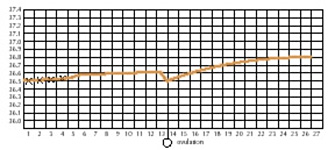
If the post-ovulatory phase is not high enough or the pre-ovulatory phase is not low enough, or if the increase in temperature after ovulation is too gradual, we may suspect endometriosis even before other signs and symptoms occur.
According to western medicine endometriosis is related to low levels of progesterone, interpreted in TCM as Kidney yang deficiency leading to blood stasis, since insufficient qi and yang will hinder transformation, scattering and dispersion of blood during menstruation. Alternatively if endometriosis is already present, this deficiency will result in failure to reabsorb the extravasated blood. Another common sign of endometriosis is when the BBT remains too high during menstruation or drops and then rises again at this time. This indicates possible Heart and Liver fire with insufficient Kidney yang qi to ove the cycle on into the yin phase.
In terms of presenting patterns, if the body temperature shows very little change throughout the cycle, there is likely to be a deficiency of both yin and yang, with other signs and symptoms e.g.:
• Kidney yang deficiency: low back pain, coldness, aversion to cold, cold lower abdomen, loss of libido, loose stools during or before period etc.
• Kidney yin deficiency: dizziness, five palms heat, night sweats etc.
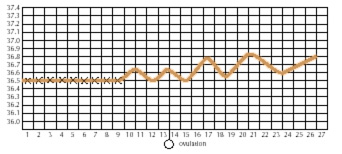
When the menstrual cycle is prolonged, this is generally due to inability of the yin to grow enough and to promote the change into ovulation and the yang post-ovulatory phase. This will be detectable on the BBT. In cases of amenorrhoea the yin essence does not grow and the cycle remains in the post-menstrual phase. This will be seen as a constantly low BBT with possible saw-tooth like variations indicating Liver and Heart fire. In this case it is necessary to treat the Kidney and nourish yin and blood paying close attention to the Heart and Liver fire.
Pregnancy
If the BBT is notably unstable during the months prior to pregnancy and conception occurs, care must be taken as there is a greater likelihood of miscarriage. It is therefore important to continue to measure the BBT for at least twelve weeks after conception where there has been a history of repeated miscarriage. If the temperature remains high for up to 16 to 18 days after ovulation, pregnancy is confirmed. Once conception has occurred, if the BBT high phase is low or unstable, Kidney yang and/or progesterone are low, and treatment to prevent miscarriage can be given. As a general rule of thumb miscarriage is mainly due to Kidney yang deficiency, whereas infertility is mainly due to Kidney yin deficiency and onsequent Liver and Heart fire.
Changes in vaginal secretions through the menstrual cycle
It is also important to note vaginal secretion, which should begin around day 5 and peak at ovulation. Fertile mucus should be wet, slippery and stretchy, with a clear appearance. Infertile mucus is sticky or tacky, cloudy, yellow or white and does not feel wet.
Observation of bleeding
Only when menstruation is regular can conception take place and it is therefore important to evaluate the four phases of the menstrual cycle and treat accordingly.
• Day 1 of cycle; bleeding begins. Check the blood flow, quantity and quality of blood, presence of mucus or blood clots, duration of flow.
• Day 1: usually light flow; if heavy there is the possibility of Heart or Liver fire.
• Day 2-3: the main blood flow should be bright, red and fluid.
• Day 4-7: bleeding finishes; if the bleeding is longer, or there is spotting, blood stasis can be suspected, or if ccompanied by a dragging down sensation, Spleen qi deficiency.
If the period is too light e.g. less than 3 days (changing pads less than 2 to 3 times a day), then the endometrium is too thin and will hinder pregnancy. There is likely to be blood deficiency and it is necessary to tonify the Spleen and blood to nourish the lining of the endometrium with Cultivate the Uterus Decoction (see below).
As bleeding finishes, the yin starts to grow. During menstruation the extreme yang of the post-ovulatory phase is transforming to yin, at which point it is important to avoid blood stasis and ensure complete discharge of old blood from the uterus (failure of this discharge is marked by an incomplete drop in BBT).
Summary of menstrual phases
Postmenstrual phase “yin growing and yang consuming”
During the first two to three days after menstruation, the Liver yin is still low and hormone levels are growing. After day eight to ten, yin levels suddenly rise and mucus should increase in quantity and become characteristically stretchy.
When yin grows, yang is consumed and the BBT drops. On day ten to thirteen, dependent on sufficient growth of yin, ovulation occurs. Treatment emphasis in the post menstrual phase is to ensure the sufficient growth of yin in preparation for ovulation.
Mid-cycle ovulation phase “extreme yin turns to yang”
At this stage female hormones are at their highest. The activity of qi and blood is most active in the Liver and Heart, and the Conception and Penetrating vessels. This may cause some abdominal distention and pain which is normal, but extreme pain may indicate damp or blood stasis in the ovaries. The sign that the yin has reached its peak is seen in the larger volume of egg-white like discharge which should last at least three days.
Pre menstrual phase
At this stage the BBT starts to rise, indicating the onset of the yang stage. Since yin is the material basis of yang, it is essential to nourish the yin throughout this stage, in the same way that yang must be supported throughout the earlier yin phase of the cycle. The ebb and flow of the menstrual cycle relies on the inter-consuming of yin and yang without which there would be no physiological change. Likewise the balance of the two is essential. Often in cases where women have sufficiently high female hormone levels, without the fine balance between the two (the yin/yang phase) and the smooth transition from one to the other, conception will not occur. For example some women have very high female hormones and yet no conception.
Treatment throughout the cycle
Post menstrual phase
If the yin is deficient it is important to begin to nourish it at the stage that it begins to grow, which occurs in the latter part of the menstrual bleed and before the bleeding has finished. This ensures a good foundation for yin to grow and gives a better result than starting to treat after the period. Therefore start to nourish the yin and blood on day three of the cycle, coupled with treatment to address Heart or Liver fire if necessary. This will be evident where there is a saw-tooth pattern in the post-menstrual phase of the BBT along with evident symptoms and signs of spirit disturbance. Too much heat in the Heart or Liver will impede the effective growth and completion (fruition) of the yin, essential in this phase.
Treatment uses
“Nourish the Yin to Establish Yang Decoction” (Yang Yin Dian Ji Wan), based on Gui Shao Di Huang Wan.
Dang Gui (Radix Angelicae Sinensis) 9
Bai Shao (Radix Paeoniae Lactiflorae) 9
Ze Xie (Rhizoma Alismatis Plantago-aquaticae) 6
He Huan Pi (Cortex Albizziae Julibrissin) 9
Huai Niu Xi (Radix Achyranthis Bidentatae) 6
Shan Yao (Radix Dioscoreae Oppositae) 9
Ye Jiao Teng (Caulis Polygoni Multiflori) 6
Sheng Di Huang (Radix Rehmanniae Glutinosae) 9
Mu Dan Pi (Cortex Moutan Radicis) 9
Fu Ling (Sclerotium Poriae Cocos) 9
Notes and modifications
• To ensure fulfilment of yin, add either Xu Duan (Radix Dipsaci) or Tu Su Zi (Fructus Perillae Frutescentis).
• Treatment to nourish yin and blood during menstruation might prevent all the menstrual blood from being completely discharged. To avoid this, on day 1 and 2 of treatment you can add Chi Shao (Radix Paeoniae Rubrae) or Shan Zha (Fructus Crataegi) or Yi Mu Cao (Herba Leonuri Heterophylli) only until the period stops.
• It is important in both phases of the cycle to quieten the Heart and soothe Liver qi. If there are any indications of fire e.g. saw-toothed pattern on the BBT, add Gou Teng (Ramulus Uncariae Cum Uncis).
• To promote nourishment of female essence add Gui Ban (Plastrum Testudinis) or Mu Li (Concha Ostreae) in cases where there is little fertile mucous or the presence of obvious signs of yin deficiency.
• If there signs of leakage of yin e.g. marked leucorrhoea or night sweating add Duan Mu Li (Concha Ostreae) and Gan Cao (Radix Glycyrrhizae Uralensis).
• In cases of amenorrhoea the woman remains in the postmenstrual phase in which case promotion of ovulation is essential.
Ovulation
Many gynaecological problems such as infertility, uterine bleeding, amenorrhoea, dysmenorrhoea, endometriosis etc. can be greatly improved by promoting ovulation. Treatment to promote ovulation is usually started around day 10.
In cases of amenorrhoea due to deficiency of yin and blood, it is important to ensure that sufficient nourishing treatment is given first (observed as normalisation of the BBT and improvement of other possible symptoms and signs).
The timescale (i.e. the number of days around ovulation) is short so dosages are increased and acupuncture added.
At ovulation the main principle is to activate circulation of qi and blood and to promote the transformation of yin into yang using Bu Shen Cu Pai Luan Tang:
Dang Gui (Radix Angelicae Sinensis) 10
Bai Shao (Radix Paeoniae Lactiflorae) 10
Nu Zhen Zi (Fructus Ligustri Lucidi) 10
Hong Hua (Flos Carthami Tinctorii) 10
Gou Qi Zi (Fructus Lycii Chinensis) 10
Mu Dan Pi (Cortex Moutan Radicis) 10
Fu Ling (Sclerotium Poriae Cocos) 8
Xu Duan (Radix Dipsaci) 10
Tu Si Zi (Semen Cuscutae) 10
Dan Shen (Radix Salviae Miltiorrhizae) 10
Chao Xiang Fu (Toasted Rhizoma Cyperi Rotundi)
Notes and modifications
• Hong Hua, Dan Shen and Chao Xiang Fu both have a specific effect on promoting ovulation.
• This prescription tonifies the Kidneys to promote ovulation and is particularly effective if there is insufficient vaginal secretion.
• If there are any signs or symptoms of Liver qi stagnation they must be addressed, preferably with acupuncture.
• It is common to add strong yang tonics to prescriptions to promote ovulation in order to give motive force to help yin/ oestrogen reach its peak for ovulation to take place, especially in cases where there is apparent yang deficiency. Suitable additions are Ba Ji Tian (Radix Morindae Officinalis), Tu Si Zi (Semen Cuscutae), Rou Cong Rong (Herba Cistanches), Lu Jiao Jiao (Colla Cornu Cervi) or Yin Yang Huo (Herba Epimedii). Note that the combination of Tu Si Zi and Rou Cong Rong is known as Tu Reng San which is noted for its ability to increase production of sexual hormones.
• If the quality of the ovaries is poor (this may only be known from exploratory surgery or tests done to evaluate the ovaries) use one or two of the following: Lu Jiao Shuang (Cornu Cervi Gelatinum), Sheng Di Huang (Radix ehmanniae Glutinosae), Yin Yang Huo (Herba Epimedii), Gou Qi Zi (Fructus Lycii Chinensis).
• If there are obvious signs of phlegm or polycystic ovaries, at ovulation you must warm yang, resolve phlegm and activate qi and blood. Use Wen Yang Hua Tan Tang: Ba Ji Tian (Radix Morindae Officinalis), Hong Hua (Flos Carthami Tinctorii), Cang Zhu (Rhizoma Atractylodis), Dan Nan Xing (Rhizoma Arisaematis cum Felle Bovis), Yin Yang Huo (Herba Epimedii), Shan Zha (Fructus Crataegi), Fu Ling (Sclerotium Poriae Cocos) , Xu Duan (Radix Dipsaci), Zhi Ke (Fructus Citri seu Ponciri), Chen Pi (Pericarpium Citri Reticulatae); and add two or three of the following: Bie Jia (Carapax Amydae Sinensis), Wang Bu Liu Xing (Semen Vaccariae Segetalis), Di Long (Lumbricus) [which penetrates and reduces thickening tissue, resolves adhesions in the pelvic cavity] and Shan Zha (Fructus Crataegi)(particularly good for olycystic ovaries).
• If there are signs of Spleen qi deficiency and damp, add Chao Dang Shen (toasted Radix Codonopsis Pilosulae), Bai Zhu (Rhizoma Atractylodis Macrocephalae) and Shan Yao (Radix Dioscoreae Oppositae).
• If there are obvious signs of Liver and Heart qi stagnation base the formula on Xiao Yao Wan (Rambling Powder): Dang Gui (Radix Angelicae Sinensis) 10g, Bai Shao (Radix Paeoniae Lactiflorae) 10g, Shan Zha (Fructus Crataegi) 10g, Yu Jin (Tuber Curcumae) 10g, Fu Ling (Sclerotium Poriae Cocos) 6g, Chai Hu (Radix Bupleuri) 6g, Yuan Zhi (Radix Polygalae Tenuifoliae) 6g, Shi Chang Pu (Rhizoma Acori Graminei) 10g, Dan Shen (Radix Salviae Miltiorrhizae) 10g, He Huan Pi (Cortex Albizziae Julibrissin) 10g.
• If there is bleeding at ovulation there is likely to be yin deficiency and hyperactivity of the Liver, in which case add Han Lian Cao (Herba Ecliptae Prostatae) and Nu Zhen Zi (Fructus Ligustri Lucidi).
The importance of Heart and Kidney Harmony at ovulation
The Heart rules the blood vessels and their function, which ensures that the supply of blood and ying (nutritive) qi is never broken. The bao mai and bao luo, the uterine vessels and collaterals, fall under the control of the Heart. The Heart and the Heart spirit therefore play an important role in the “filling” and “emptying” of the uterus. The Su Wen states that if Heart qi cannot descend, the uterine vessels will become obstructed and menstruation will stop. In 1612 in Song’s Secrets of Gynaecology, it says “the Heart controls the movement of blood, but if it falls into a startled, fearful
state, the spirit has no support and blood scatters” which causes the menstrual blood to cease moving, often giving rise to amenorrhoea. “Because the seven emotions injure the Heart, Heart qi stops and knots up, so blood stops and does not move. One should regulate Heart qi and open the flow in the Heart channel to produce blood. Then the period will naturally flow.” Ji Yan Gan Mu (Compendium of the Benefits of Yin by Zhu Dan-xI, 1620.
• Where there is obvious spirit disturbance accompanied by Heart fire, a good prescription to promote ovulation and open the uterus is based on Pai Luan Tang: Bai Zi Ren (Semen Biotae Orientalis) 10g to calm the spirit, Dan Shen (Radix Salviae Miltiorrhizae) 10g to promote ovulation, Dang Gui (Radix Angelicae Sinensis) 10g, Chi Shao (Radix Paeoniae Rubrae) 10g, Chuan Xiong (Radix Ligustici Wallichii) 10g, Tu Su Zi (Fructus Perillae Frutescentis) 10g, Xu Duan (Radix Dipsaci) 10g which in combination with Tu Si Zi strongly tonifies Kidney yang, Sheng Di Huang (Radix
Rehmanniae Glutinosae) 10g, Niu Xi (Radix Achyranthis Bidentatae) 10g, Hong Hua (Flos Carthami Tinctorii) 5g, Gou Teng (Ramulus Uncariae Cum Uncis) l2g and He Huan Pi (Cortex Albizziae Julibrissin) 12g which in combination with Gou Teng is very good at calming Liver and Heart fire.
• If there are obvious signs of Heart-Kidney disharmony, add Jiao Tai Wan (The Great Connector) to the prescription: Huang Lian (Rhizoma Coptidis) 6-8g, and Rou Gui (Cortex Cinnamomi Cassiae) 3g. This prescription is applicable when the Kidney yang is unable to provide for the Heart yang, or likewise when the yin of both the Heart and Kidney are deficient.
• It is said that the uterine vessels relate above to the Heart and below to the Kidneys. The uterus is in-between. It is therefore essential to firm the Kidneys before tonifying the Heart and likewise to pacify the Heart before tonifying the Kidneys. Where there is poor ovarian and pituitary function, one should always suspect the problem is based in the Heart. Using the BBT one can tell whether heat from the Heart or the Liver is becoming excessive and thus pathogenic, disturbing the harmony between Heart and Kidney and hindering the consolidation of blood and yin in the first half of the cycle and also the growth and maintenance of yang in the premenstrual phase. For this reason it is important to remain relaxed when trying to conceive. If the Heart or Liver qi rebels upwards, the qi will not sink to the uterus and the fallopian tubes, affecting fertility. When calming the Heart and Liver, sweet flavours are helpful. Gan Mai Da Zao Tang (Licorice, Wheat and Jujube Decoction) can be incorporated into the prescription: Gan Cao (Radix Glycyrrhizae Uralensis) 9g, Fu Xiao Mai (Semen Tritici Aestevi Levis) 12g, Da Zao (Fructus Zizyphi Jujubae) 10g.
The uterus will open both at ovulation: the time of the dynamic yin/yang interaction, but also when the Heart spirit is in emotional harmony – where the “intertwining of two spirits combine to create form”. At this point (where there is emotional harmony between both participants) the central nervous system can reach such excitation and so stimulate the endocrine system to provoke an additional ovulation resulting in pregnancy.
Premenstrual Treatment
The main treatment principle is to tonify yang and help qi which will have the effect of raising the progesterone level. It is important to understand the principle of tonifying fire within water, without which it is difficult for yang to reach the high levels required for conception and the continuation of pregnancy during the luteal phase. The prescription is therefore based on You Gui Wan (Restore the Right Kidney Pill):
Shu Di Huang (Radix Rehmanniae Glutinosae Conquitae) l0g
Lu Jiao Shuang (Cornu Cervi Gelatinum) 9g (helps maintain high phase of the cycle and also activates blood).
Tu Su Zi (Fructus Perillae Frutescentis) 10g
Rou Cong Rong (Herba Cistanches) 9g
Shan Yao (Radix Dioscoreae Oppositae) l0g
Ba Ji Tian (Radix Morindae Officinalis) 10g
Mu Dan Pi (Cortex Moutan Radicis) 10g
Shan Zhu Yu (Fructus Corni Officinalis) 9g
If there are signs of poor luteal phase shown on the BBT or through medical tests, the best prescription to use is Zhu Yu Tang (Help Conception Decoction), which addresses both yang and blood by warming the uterus and maintaining its motive force on the one hand, and nourishing blood on the other.:
Dang Gui (Radix Angelicae Sinensis)
She Chuang Zi (Fructus Cnidii Monnieri)
Bai Shao (Radix Paeoniae Lactiflorae)
He Huan Pi (Cortex Albizziae Julibrissin)
Gou Teng (Ramulus Uncariae Cum Uncis), or
Chai Hu (Radix Bupleuri)
Du Zhong (Cortex Eucommiae Ulmoidis)
Lu Jiao Shuang (Cornu Cervi Gelatinum)
Yin Yang Huo (Herba Epimedii)
Shan Yao (Radix Dioscoreae Oppositae)
Fu Ling (Sclerotium Poriae Cocos)
Mu Dan Pi (Cortex Moutan Radicis)
Xu Duan (Radix Dipsaci)
Tu Su Zi (Fructus Perillae Frutescentis)
• It is also crucial to treat close to menstruation. The yang has already peaked and may have stirred up fire in the Heart and Liver, giving rise to breast distention, stuffy chest, restlessness, headache, insomnia and irritability. Treatment is to maintain vigorous yang, but also to clear fire from the Heart and Liver. If a woman has an unstable BBT in the high (post-ovulation) phase, you must be careful, when clearing heat, not to damage the yang qi. Base the prescription on Dan Zhi Xiao Yao San (Augmented Rambling Powder), monitoring the BBT to ensure the yang phase remains high.
• If there are signs of qi stagnation, tonify yang by promoting qi with Zhen Wu Tang (True Warrior Decoction):
Dang Shen (Radix Codonopsis Pilosulae) 12g
Ba Ji Tian (Radix Morindae Officinalis) 10g
Yi Yi Ren (Semen Coicis Lachryma-jobi) 15g
Tu Su Zi (Fructus Perillae Frutescentis) 10g
Lu Jiao Shuang (Cornu Cervi Gelatinum) l0g
Xiang Fu (Rhizoma Cyperi Rotundi) 6g
Bai Zhu (Rhizoma Atractylodis Macrocephalae) 10g
Shan Yao (Radix Dioscoreae Oppositae) 10g
• If there is premenstrual abdominal or breast distention add Chai Hu (Radix Bupleuri), Qing Pi (Pericarpium Citri Reticulatae Viride) and He Huan Pi (Cortex Albizziae Julibrissin).
• If there are signs of heat add Chuan Lian Zi (Fructus Meliae Toosendan).
• If endometriosis is a problem, add two or three of the following blood-stagnation removing herbs: Chuan Xiong (Radix Ligustici Wallichii), Xiang Fu (Rhizoma Cyperi Rotundi), Dang Gui Wei (Extremitas Radix Angelicae Sinensis), Chi Shao (Radix Paeoniae Rubrae), Tao Ren (Semen Persicae), Yan Hu Suo (Rhizoma Corydalis Yanhusuo), Hong Hua (Flos Carthami Tinctorii).
During menstruation “The mutual flux of yin and yang”
The mutual flux of yin and yang depends on the harmonious function of the Heart-Kidney-uterus axis with essence and spirit acting as one. If the menstrual flow is heavy on day 1, this is pathological. It should normally take a day after the temperature has dropped to generate the qi to push the blood. Good flow should start on day 2. If it starts too fast, this indicates excessive heat or Spleen qi deficiency losing control of blood. If treatment is given during the first three days of menstruation, for example in case of uterine fibroids, endometriosis or other cases of severe blood stasis, the primary principle is to regulate qi and blood as well as to benefit the Kidneys:
Dang Gui (Radix Angelicae Sinensis) 9g
Shan Zhu Yu (Fructus Corni Officinalis) 6g
Chi Shao (Radix Paeoniae Rubrae) 9g
Chuan Niu Xi (Radix Achyranthis Bidentatae) 6g
Mu Dan Pi (Cortex Moutan Radicis) 9g
Hong Hua (Flos Carthami Tinctorii) [especially in cases of dysmenorrhoea] 6g
Yi Mu Cao (Herba Leonuri Heterophylli) 6g
Shan Yao (Radix Dioscoreae Oppositae) 9g
Zhi Xiang Fu (honey-fried Rhizoma Cyperi Rotundi) 6g
• If there is blood deficiency, you must always address the Spleen, in which case add Dang Shen (Radix Codonopsis Pilosulae) and Bai Zhu (Rhizoma Atractylodis Macrocephalae), (both dry fried to work better on the middle jiao) to the prescription.
• If there is disruption in the Sanjiao pathway it may prevent Heart fire from warming the Kidney, or Kidney yin from nourishing the Heart. Possible manifestations include palpable heat in the upper jiao and coldness in the lower jiao, or weak pulses on right chi position. The treatment principle is to open the Sanjiao passages by adding one or two of the following: Yuan Zhi (Radix Polygalae Tenuifoliae), Shi Chang Pu (Rhizoma Acori Graminei) [reconnects the Heart to the Kidneys], Ba Ji Tian (Radix Morindae Officinalis), Ban Xia (Rhizoma Pinelliae Ternatae).
The uterus
The importance of the uterus when treating infertility is often overlooked in Chinese medicine. The main function of the uterus is to dominate menstruation and conception. It both stores and eliminates, like the other extraordinary fu. The opening and closing of the uterus relies upon the Heart and the Kidneys. The Kidneys store the essence and control the function of closing and storage of the uterus to prevent miscarriage. The opening of the uterus relies upon the Heart. If the Heart yang moves and is not quiet, it can cause the opening of the uterus during pregnancy causing miscarriage. Likewise if Heart yang is stagnant there will be no opening of the uterus thus obstructing fertility.
There are two types of uterine vessels, the bao mai and the bao luo. The bao mai is a single vessel which links the Heart to the uterus: “If the Heart blood and Heart qi smoothly descend to reach the uterus. menstruation and pregnancy can occur without incident” (Su Wen chapter 47). The bao luo are uterine collaterals which link the Kidneys to the uterus and are the route by which the Kidneys transport essence directly to the uterus.
Some miscarriages may occur within the 14 days following ovulation due to an inadequate luteal phase, which arises from yang deficiency in the uterus and therefore the uterus expels more than it conserves, and these cases should be treated by warming the yang, increasing qi and adding herbs to strengthen the ‘holding-in’ function. In such cases (where it is not always evident that miscarriage has occurred) as well as in cases of an evident history of repeated miscarriage, the later stages of the BBT (after day 21) should be monitored to ensure that the temperature remains high and continues to do so until at least 12 weeks into the pregnancy. In patients with a history of repeated miscarriage, the recommended prescription is Shu Gong Tang (Bind the Uterus Decoction). Note that if conception should occur during the course of treatment, Ren Shen should be removed and substituted with Dang Shen and all the doses reduced. Once the danger period has passed the precription can be stopped.
Ren Shen (Radix Ginseng) 10g
Ba Ji Tian (Radix Morindae Officinalis) 10g
Lu Jiao Shuang (Cornu Cervi Gelatinum) 10g
Tu Si Zi (Fructus Perillae Frutescentis) 10g
Shan Yao (Radix Dioscoreae Oppositae) 10g
Wu Wei Zi (Fructus Schisandrae Chinensis) 6g
Shu Di Huang (Radix Rehmanniae Glutinosae Conquitae) 10g
Bai Shao (Radix Paeoniae Lactiflorae) 10g
Contrarily, if the uterus conserves more than it expels, for example where there is amenorrhoea and infertility due to absent or poor ovulation, and inadequate production of fertile mucus, then there is uterine yin deficiency. Here we could use Yang Gong Tang (Cultivate the Uterus Decoction).
Dang Gui (Radix Angelicae Sinensis) 10g
Bai Shao (Radix Paeoniae Lactiflorae) 10g
Chong Wei Zi (Semen Leonuri Heterophylli) 15g
Shan Yao (Radix Dioscoreae Oppositae) 10g
Tu Su Zi (Fructus Perillae Frutescentis) 10g
Rou Cong Rong (Herba Cistanches) 10g
Mu Li (Concha Ostreae) 20g
Other miscellaneous factors giving rise to infertility
If the temperature is above 38°C with signs of abdominal pain and distention, thick yellow leucorrhoea and a thick yellow tongue-coating, you can suspect pelvic inflammatory disease, which must be treated accordingly until the temperature drops to below 37.5°C in acute cases, and back to 37°C in chronic cases.
Fallopian tube obstruction, perhaps with a history of salpingitis or acute or chronic pelvic inflammatory disease, may give rise to mucus or blood clots in the menstrual blood. The following prescription may be used for at least ten days after the end of menstrual bleeding (alternatively it can be taken throughout the non-bleeding part of the cycle):
Wei Ling Xian (Radix Clemetidis Chinensis) 12g
Huang Qi (Radix Astragali) 20g
Xia Ku Cao (Spica Prunellae Vulgaris) 12g
Zhe Bei Mu (Bulbus Fritillariae Thunbergii) 12g
Zhi Ke (Fructus Citri seu Ponciri) 9g
Pu Gong Ying (Herba Taraxaci Mongolici cum Radice) 15g
Dan Shen (Radix Salviae Miltiorrhizae) 12g
Gui Zhi (Ramulus Cinnamomi Cassiae) 9g
Lu Lu Tong (Fructus Liquidambaris Taiwanianae) 15g
Shui Zhi (Hirudo seu Whitmaniae) 9g
Xue Jie (Sanguis Draconis) 6g
Zao Jiao Ci (Spina Gleditsiae Sinensis) 12g
Notes and modification
• Wei Ling Xian is good for pains in the legs which may occur in cases of severe dysmenorrhoea. Care should be taken not to use too high a dose as it can damage the zheng qi. Huang Qi increases qi movement. Xia Ku Cao and Zhe Bei Mu are both good for clearing phlegm. Pu Gong Ying has an anti inflammatory action. Dan Shen moves the blood. Gui Zhi moves yang to move the blood, and if combined with Fu Ling (Sclerotium Poriae Cocos) is able to dredge the fallopian tubes).
• If there is excessive vaginal discharge with no signs of pelvic or vaginal infection, tonify Kidney yang by adding Lu Jiao Shuang (Cornu Cervi Gelatinum), Xu Duan (Radix Dipsaci), Hu Zhang (Radix et Rhizoma Polygoni Cuspidati) etc.
• If there are signs of heat and damp use Bai Jiang Cao (Herba cum Radice Patriniae), Gan Cao (Radix Glycyrrhizae Uralensis), Ze Xie (Rhizoma Alismatis Plantagoaquaticae), Bai Hua She She Cao (Herba Oldenlandiae Diffusae) and Hong Teng (Caulis Sargentodoxae Cuneatae).
The addition of herbal compresses is often more effective for blocked tubes and can be used as well as taking an internal prescription.:
Da Huang (Rhizoma Rhei) 30g
Hong Teng (Caulis Sargentodoxae Cuneatae) 30g
Ji Xue Teng (Radix et Caulis Jixueteng) 30g
Chao Ai Ye (Folium Artemisiae) 30g
Dang Gui Wei (Extremitas Radix Angelicae Sinensis) 30g
Ze Lan (Herba Lycopi Lucidi) 15g
Bai Zhi (Radix Angelicae) 15g
Chuan Jiao (Pericarpium Zanthoxyli Bungeani) 15g
Hu Zhang (Radix et Rhizoma Polygoni Cuspidati) 15g
Chuan Xiong (Radix Ligustici Wallichii) 15g
Xiao Hui Xiang (Fructus Foeniculi Vulgaris) 15g
Gui Zhi (Ramulus Cinnamomi Cassiae) 15g
San Leng (Rhizoma Sparganii) 15g
E Zhu (Rhizoma Curcumae Zedoariae) 15g
Wu Yao (Radix Linderae Strychnifoliae) 6g
Xi Xin (Herba Asari cum Radice) 6g
Wu Tou (Radix Aconiti) 6g
Chuan Wu (Radix Aconiti) 6g
Jiang Xiang (Lignum Dalbergiae Odoriferae) 6g
Bing Pian (Borneol) 3g
Crush all the ingredients. Put 75g in a cloth with 50% water and 50% gin. Place on the abdomen over the fallopian tubes with a hot water bottle on top. The pungent herbs will penetrate the skin via the alcohol. Use for ten days after each period. Each 75g batch of herbs can be used again as long as it is still fragrant. A towel may be placed between the hot water bottle and the herbs.
Case histories
This method of using the BBT for diagnostic purposes can also be helpful when treating disorders such as cycle related migraines, skin conditions (particularly acne), and growth and sexual maturity problems at puberty, as well as the more obvious gynaecological complaints. Along with the pulse, tongue and personal impressions the chart can give valuable information about the status of the yin and yang, Heart and/or Liver fire, and more. It may also be helpful as a guideline to recovery in some cases, by observing how the chart changes.
Case history 1: Sarah 34, infertility
Sarah has been trying since 1994 to conceive. She previously used the contraceptive pill for 10 years. She had one pregnancy at the age of 21, which was terminated. For 18 months after coming off the pill her period came every 31 days (a classic sign of long term use of the contraceptive pill damaging yin and blood). The menstrual flow contains some blood clots and is painful. She also suffers from acne, a low sex drive, feels very run down, and suffers from premenstrual tension, bloating, soreness in the breasts and around the site of the right ovary, thrush, a tendency to constipation and dizziness on sudden standing. She is now obsessed with becoming pregnant and gets very low and depressed about it. She has been taking Prozac for one year. She had an unsuccessful IVF cycle in 1996. Her tongue is pale with a thick yellow coating, and her pulse is thin and wiry.
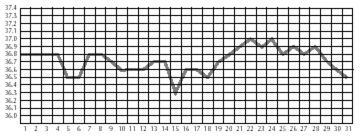
The chart indicated the presence of Heart and Liver fire(too high and saw-toothed post-menstrual phase) and deficiency of Kidney yang (erratic initial rise in the post-ovulatory BBT). The symptoms and signs also reflected the presence of dampness, damp-heat, blood deficiency and blood stasis.
Treatment principle: tonify blood, resolve stasis, clear damp and tonify Kidney yang. She also had acupuncture to calm Liver/ Heart fire.
Premenstrual prescription: to regulate blood and maintain the high phase:
Lu Jiao Jiao (Colla Cornu Cervi) 6g
Dang Gui (Radix Angelicae Sinensis) 6g
He Shou Wu (Radix Polygoni Multiflori) 6g
Fu Ling (Sclerotium Poriae Cocos) 6g
Shan Yao (Radix Dioscoreae Oppositae) 6g
Shan Zhu Yu (Fructus Corni Officinalis) 6g
Du Zhong (Cortex Eucommiae Ulmoidis) 6g
Tu Su Zi (Fructus Perillae Frutescentis) 6g
Mu Dan Pi (Cortex Moutan Radicis) 6g
Ze Xie (Rhizoma Alismatis Plantago-aquaticae) 6g
Ban Xia (Rhizoma Pinelliae Ternatae) 6g
Da Zao (Fructus Zizyphi Jujubae) 2 pieces
Zhi Gan Cao (Radix Glycyrrhizae Praeparatae) 3g
Postmenstrual prescription: to nurture the yin and promote ovulation:
Lu Jiao Jiao (Colla Cornu Cervi) 3g
Dang Gui (Radix Angelicae Sinensis) 6g
Fu Ling (Sclerotium Poriae Cocos) 6g
Mu Dan Pi (Cortex Moutan Radicis) 6g
He Shou Wu (Radix Polygoni Multiflori) 6g
Hong Hua (Flos Carthami Tinctorii) 6g
Tu Si Zi (Semen Cuscutae) 6g
Yin Yang Huo (Herba Epimedii) 6g
Shan Zha (Fructus Crataegi) 6g
Shan Yao (Radix Dioscoreae Oppositae) 6g
Shan Zhu Yu (Fructus Corni Officinalis) 6g
Da Zao (Fructus Zizyphi Jujubae) 2 pieces
Zhi Gan Cao (Radix Glycyrrhizae Praeparatae) 3g
After one cycle her periods were already less painful and clotted. Her eyes were brighter and she had much more energy. She took the herbs for ten weeks and became pregnant the following month.
Case history 2: Fiona 38. Infertility with fibroids
Fiona has been trying to conceive for ten years. She took the contraceptive pill in her mid-twenties for five years. She was prescribed Clomid (a fertility drug) for one year, seven years ago. Last year she had a successful IVF cycle but miscarried at three months due to a fibroid. She has had six operations in the last six years for fibroids and fallopian tube adhesions, as well as D&C’s. Her cycle is 28 days and she experiences sharp stabbing pains in the lower abdominal area which come and go throughout the month, as well as severe pain during ovulation. Her period is characterised by heavy and clotted flow and accompanied by sharp stabbing pains. She is obviously anxious and upset about her infertility and the possibility of a hysterectomy due to the fibroid.
Her tongue is darkish red with a thin yellow coating and her pulse is rapid, and slippery on the right side.
Note: during the first two days of the cycle, the temperature is still high, indicating insufficient expulsion of blood. This is followed by a saw-tooth effect indicating heat in the blood (Liver and Heart fire). After ovulation the yang phase fails to develop properly, at which point yang stimulating herbs must be given.
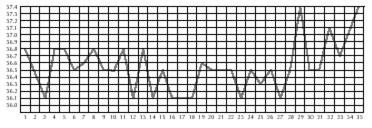
According to the evidence of the chart and her symptoms and signs, the treatment principle was to tonify yang, clear damp heat in the lower jiao and break down blood stagnation to treat the fibroid.
Premenstrual prescription
Dang Gui (Radix Angelicae Sinensis) 8g
Tu Su Zi (Fructus Perillae Frutescentis) 8g
Bai Zhu (Rhizoma Atractylodis Macrocephalae) 8g
Chi Shao (Radix Paeoniae Rubrae) 8g
Ba Ji Tian (Radix Morindae Officinalis) 6g
Lu Jiao Shuang (Cornu Cervi Gelatinum) 6g
Yi Yi Ren (Semen Coicis Lachryma-jobi) 12g
Shan Zha (Fructus Crataegi) 6g
Pu Huang (Pollen Typhae) 10g ( last two both for fibroids)
Fu Ling (Sclerotium Poriae Cocos) 6g
Zhi Gan Cao (Radix Glycyrrhizae Praeparatae) 3g
During menstruation prescription
Dang Gui Wei (Extremitas Radix Angelicae Sinensis) 9g
Chuan Xiong (Radix Ligustici Wallichii) 8g
Tao Ren (Semen Persicae) 6g
Hong Hua (Flos Carthami Tinctorii) 6g
Dan Shen (Radix Salviae Miltiorrhizae) 9g
Ji Xue Teng (Radix et Caulis Jixueteng) 9g
Xiang Fu (Rhizoma Cyperi Rotundi) 6g
Fu Ling (Sclerotium Poriae Cocos) 6g
Pu Huang (Pollen Typhae) 9g
Yan Hu Suo (Rhizoma Corydalis Yanhusuo) 8g
Gan Cao (Radix Glycyrrhizae Uralensis) 3g
Before ovulation prescription
Dang Gui (Radix Angelicae Sinensis) 8g
Chi Shao (Radix Paeoniae Rubrae) 9g
Gou Teng (Ramulus Uncariae Cum Uncis) 15g
Nu Zhen Zi (Fructus Ligustri Lucidi) 9g
Mu Dan Pi (Cortex Moutan Radicis) 6g
Bai Shao (Radix Paeoniae Lactiflorae) 9g
Xu Duan (Radix Dipsaci) 6g
Yan Hu Suo (Rhizoma Corydalis Yanhusuo) 6g
Lu Jiao Jiao (Colla Cornu Cervi) 4g (to activate blood)
Mu Xiang (Radix Saussureae seu Vladimirae) 6g
Pu Huang (Pollen Typhae) 9g
Gan Cao (Radix Glycyrrhizae Uralensis) 3g
Her treatment is currently continuing. So far the pains have improved, indeed have virtually disappeared, and the blood flow improved. She feels less anxious in herself.
References
The material in this article is gathered from a number of sources and from my own clinical experience. I am especially indebted to the following sources:
• Excerpts from Dr. Xia Gui Sheng lectures, Exploring Infertility, Sydney 1995.
• Clinical work with Dr. Xia Gui Sheng at Nanjing University Hospital 1997.
• Steven Clavey’s newsletter ACMERC vo2:3. On the Uterus taken from Jane Lyttleton’s work with Dr. Xia Gui Sheng.
• Notes take from Steven Clavey’s lecture On Endometriosis, London 1998.
Virginia Wood practised Chinese medicine in Norwich for twelve years, more recently specialising in gynaecology. She spent six months working in a gynaecology clinic in New Zealand and then in China with Dr Xia. She now lives and practices in Tuscany, Italy.
